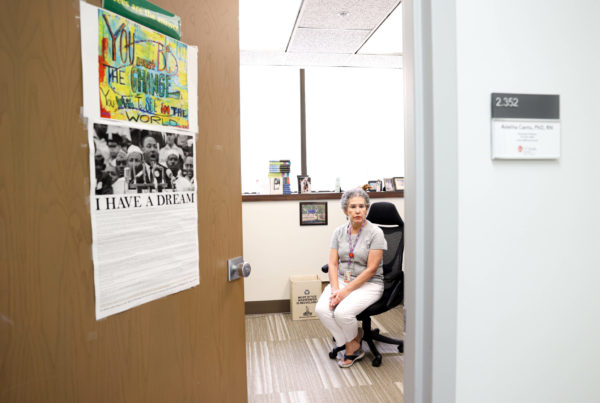When seeking asylum in the United States, a migrant’s most vital belonging is their immigration paperwork. Any mistake or misunderstanding with those documents might not only delay their case, but get them deported.
That’s why reports of government agents purposefully putting wrong addresses on migrants’ release forms has sent up red flags among immigration advocates. How could this happen, and what does it mean for asylum-seekers?
Adolfo Flores, who has been following this story for Buzzfeed News, spoke with the Texas Standard on how this affects asylum-seekers. Listen to the story above or read the transcript below.
This transcript has been edited lightly for clarity.
Texas Standard: Purposefully misdirecting migrants on their release – is this rumor, or is this real?
Adolfo Flores: No, it’s real. It’s been happening for a couple of months and something that some of the attorneys I talked to have been tracking and something that I’ve also been talking to organizations about. So it’s definitely been happening, and there’s hundreds of cases.
You mentioned eight men who ended up in Sacramento at a closed office building. What’s the backstory there?
The eight men — it was two separate flights — flew in from Texas to Sacramento with this address on their immigration release forms. And they walked there — it was about 15 miles. When they got there, it was closed. The address that was put on the forms by an immigration official – not sure if it was Border Patrol or ICE – I think it belonged to an advocacy organization. And so the men didn’t give them that address. This was an address that U.S. immigration authorities put on their paperwork.
Well, how does that usually play out? Typically, are officials supposed to ask the migrants themselves where they want to go, or do they just, on their own, make a determination?
Usually what happens is immigrants, when they’re processed, and if they’re processed into the U.S., they provide the address of a friend or a family member — just a ‘sponsor’ is what they call them — who is going to take them in. And this address is very important because this is the address where they’ll be getting court notifications and any other immigration notification. But what we’re seeing now is Venezuelans who arrive at the border – who are one of the few nationalities that are actually allowed to enter the U.S. and seek asylum – don’t have friends or family, sometimes, and increasingly so. And so when they’re about to be released, they don’t have an address to put down. And, you know, that’s a problem. You need somewhere where you can be contacted.
So what appears to be happening is, because they don’t have that address, immigration officials at the border or an ICE facility are putting down the address of NGOs — usually immigrant-serving NGOs — but not necessarily ones that are equipped to deal with this population. Sometimes what happens is the forms go to these organizations like Catholic Charities in New York, and they don’t even know who these people are and have no way of contacting them.
I understand that a San Antonio-based organization was responsible for paying the way for this group of eight men who wound up in Sacramento. Would that organization have provided the contact?
Not at all, because the men were released. It was Laredo, Texas, so it was at the border. And then from there, they made their way to San Antonio. So there was no contact between the organization in San Antonio and border officials.
I would imagine this is really confusing and distressing for asylum seekers. It’s hard to track for people who are here and just want to get to the bottom of this story. When this happens, how can it be fixed – or can it be?
It can be fixed, but like most things in the immigration world, it’s complicated to do. So one of the ways that you can change it is you go to an ICE office, but many of these ICE offices are overfilled with applications or sometimes are closed because of COVID. So it’s really hard to even get in there and say, ‘Hey, I have this address that’s not my address; I need to change it.’ And most immigrants, they don’t know that that’s what they can do and that they’re supposed to do that.
What are immigration advocates saying about this?
Well, they’re saying that it could have really detrimental impacts on immigrants, because if they get a court appearance notice sent to this address and they never get it, that doesn’t mean that the hearing doesn’t take place. And if they don’t show up, an immigration judge could order them deported in absentia in their absence.
Is there any evidence or any sign that this is being done maliciously to create confusion? Or does this seem to be an innocent ministerial error? How does that seem to be playing out from your reporting?
There seems to be two schools of thought on this: On one end, I’m sure that Border Patrol agents, they’re just trying to get people out of their facilities. They don’t want to hold them there any longer than they have to, and without an address, in some cases I’m sure the agents tell them it’s either ‘I put this address or you stay here longer.’ And so, in an effort to get people out of detention, they put an address to, at the very least, an immigration advocacy organization. But there’s a problem because some of these organizations are not equipped to deal with this person.
On the other hand, some advocates think that it is just being done with some malicious intent. But it’s really hard to know because DHS, Border Patrol, CBP and ICE, they haven’t really said anything. And the American Immigration Lawyers Association sent a letter to the agencies, to be like, ‘Hey, you need to clear this up.’ And I haven’t heard of what they’ve done to fix it or if it’s being addressed.














